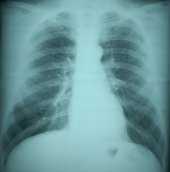CHEST RADIOGRAPHY

Glossary of Terms
Classification: In these web pages this is short for ILO classification, the assessment of a radiograph for abnormalities associated with pneumoconioses and certain other lung diseases or chest abnormalities using the standard definitions, procedures, and radiographs of the ILO system.
Blinding: Blinding is intended to prevent bias by hiding ancillary information from a reader. For a fully blinded classification, information on the reason for the reading (e.g., a contested application for compensation), the entity requesting the reading (e.g., representative of a plaintiff or defendant), the underlying source or nature of the radiographs (e.g., a cohort of sandblasters), and the examinee’s personal information (e.g., industry, job, tenure, and other health information) is not available to the reader.
Summarization: When multiple classifications exist, it is frequently necessary to derive a summary classification representing in some way the average of these multiple classifications for the specific abnormality under investigation. Various approaches are possible, and are described in the web pages for each setting.
Quality assurance: Quality assurance is the process of ensuring that classifications are sufficiently accurate for the specific setting. General information on accuracy is provided on the Issues in Classification of Chest Radiographs page, while details on quality assurance procedures are provided on the web pages for each setting.
Independence: With independent classification, multiple readers each classify the radiographs separately without other readers being present, and without knowledge of the classifications of other readers.
Surveillance: In the worker monitoring setting, surveillance is the periodic and systematic examination of the monitoring database to identify at-risk groups of workers using sentinel events and tabulation by logical categories of workers and cases.
- Page last reviewed: May 24, 2011
- Page last updated: May 24, 2011
- Content source:
- National Institute for Occupational Safety and Health Respiratory Health Division


 ShareCompartir
ShareCompartir